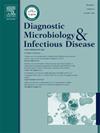Analysis of respiratory RNA virus detection in the laboratory of a teaching hospital in Shanghai from 2017 to 2023
IF 2.1
4区 医学
Q3 INFECTIOUS DISEASES
Diagnostic microbiology and infectious disease
Pub Date : 2025-02-09
DOI:10.1016/j.diagmicrobio.2025.116729
引用次数: 0
Abstract
Objective
The aim of this study was to analyze the detection and epidemiological characteristics of common influenza viruses (IVA/IVB) and respiratory syncytial virus (RSV) in a teaching hospital in Shanghai from 2017 to 2023, and to investigate the impact of the COVID-19 epidemic on the transmission and detection rates of these viruses.
Methods
Retrospective analysis of IVA/IVB and RSV cases detected in hospitals from 2017 to 2023. Data was categorized into pre, during and post outbreaks based on the timing of the COVID-19 outbreak and further subdivided by season and age group. PCR and colloidal gold methods were used for virus detection and statistical analyses were performed accordingly.
Results
Positive detection rates of pathogens were statistically different by age, period, season and detection method employed. Before the epidemic, the pathogen infections showed obvious seasonality but disappeared after 2019. Positive detection rates of influenza were higher in adolescents and young and middle-aged people while RSV detection was highest in adolescents. Detection by Gene Xpert real-time fluorescent PCR was superior in terms of timeliness and efficiency.
Conclusion
The COVID-19 pandemic and the massive public health intervention campaign have led to widespread changes in human behavior, significantly affecting the spread and activity of other seasonal respiratory viruses. Further, advances in detection methods have contributed to increased pathogen detection rates.
求助全文
约1分钟内获得全文
求助全文
来源期刊
CiteScore
5.30
自引率
3.40%
发文量
149
审稿时长
56 days
期刊介绍:
Diagnostic Microbiology and Infectious Disease keeps you informed of the latest developments in clinical microbiology and the diagnosis and treatment of infectious diseases. Packed with rigorously peer-reviewed articles and studies in bacteriology, immunology, immunoserology, infectious diseases, mycology, parasitology, and virology, the journal examines new procedures, unusual cases, controversial issues, and important new literature. Diagnostic Microbiology and Infectious Disease distinguished independent editorial board, consisting of experts from many medical specialties, ensures you extensive and authoritative coverage.

 求助内容:
求助内容: 应助结果提醒方式:
应助结果提醒方式:


